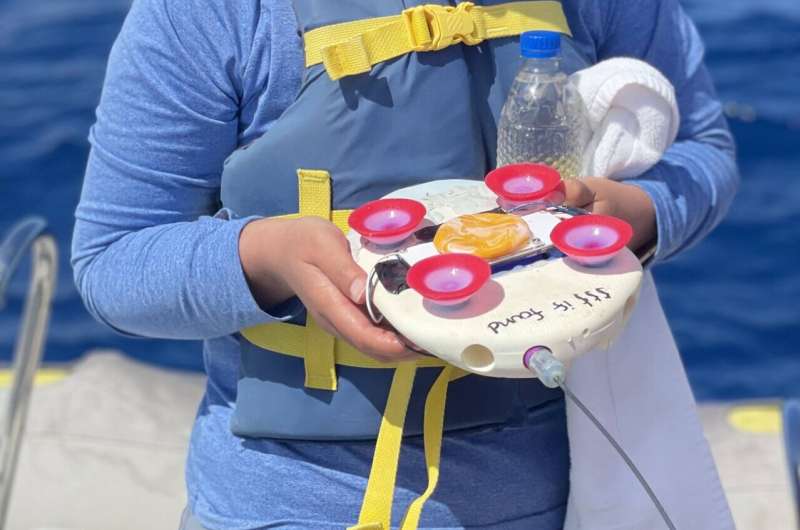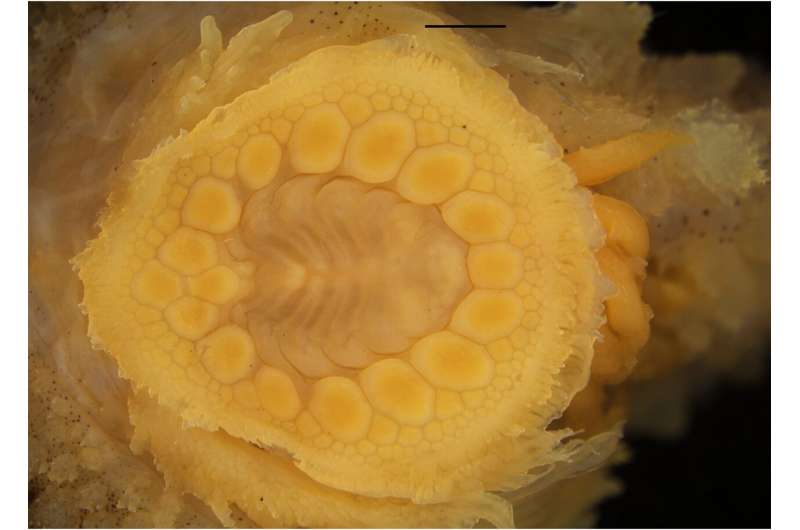This article has been reviewed according to Science X's editorial process and policies. Editors have highlighted the following attributes while ensuring the content's credibility:
fact-checked
peer-reviewed publication
trusted source
proofread
Using suction cups inspired by fish to listen in on whale conversations

In their ambitious goal to understand and ultimately communicate with sperm whales, research scientists from Project CETI have enlisted the help of unlikely collaborators—clingfish.
CETI, launched in 2020 by a team of interdisciplinary scientists, aims to listen to, contextualize, and translate the communication of sperm whales, the species with the largest brains on the planet. Key to that goal is the development of non-invasive soft devices that attach to the whales and record their vocalizations and other data.
This effort is being led by Robert Wood, Harry Lewis, and Marlyn McGrath, Professor of Engineering and Applied Sciences at the Harvard John A. Paulson School of Engineering and Applied Sciences (SEAS) and Robotics Team Lead at Project CETI, as well as a National Geographic Explorer.
Wood and his team are working to develop tags that can attach and detach from whales without causing any damage to the skin and withstand speeds up to 30 miles per hour, depths up to 1,000 meters, and temperatures as low as a few degrees Celsius.
"In developing these tags, we need a way to adhere to whales that is gentle, stable, and reversible," said Alyssa Hernandez, a postdoctoral fellow in Wood's Microbotics Lab. "We don't want to use spears, spines, hooks, or anything that could harm the whale. Adhesives also wouldn't work because we need to be able to detach the tag to retrieve the data. Suction cups are gentle on the skin and eventually detach themselves but only tend to stay on for a few hours."
Researchers on Project CETI need their listening devices to record at least a day or two of whale-to-whale conversations to understand the context of their vocalizations.
Which brings us back to clingfish.
Hernandez, who earned her Ph.D. in Organismic and Evolutionary Biology at Harvard by studying the biomechanics of how insects attach to plants, knows that nature has a few million-year head start on R&D when it comes to engineering better suction cups.
In a new paper, Hernandez and Wood, along with co-authors Jessica A. Sandoval and Michelle C. Yuen, tested a series of suction cups inspired by the suction disks of clingfish, lumpsuckers, snailfish, and river loaches. The team found that designs inspired by the shapes of clingfish, lumpsuckers, and snailfish disks may be suited to reliably withstand the shear forces of a swimming and diving sperm whale.
The research is published in Bioinspiration & Biomimetics.

Nature offers many different examples of suction disks, from the round suckers used by octopuses to the full-body, peanut-shaped disks found on loach fish.
"We often think of a suction cup as this circular thing, but in biology, that's not really the case," said Hernandez. "That was interesting for us because it raises the question: is there a reason for these different disk shapes? Is having a more elongated shape, for example, important to helping with attachment and especially in withstanding shear."
Hernandez and the team designed six different suction cups—a standard circle, two different ellipses inspired by lumpsuckers and snailfish, a peanut-shaped cup inspired by loaches, and a teardrop and bean-shaped cup inspired by clingfish. The stiffness of the cups also varied based on their shape.
The team tested each cup using a robotic arm—nicknamed "Armando"—inside a small water tank. Armando stuck the suction cup onto different substrates with varying roughness and compliance and then dragged them across the surfaces, mimicking a gentle version of the shear forces that a swimming and diving whale would generate.
The team found that a wide ellipse with middling stiffness inspired by lumpsucker and snailfish disks and the teardrop-shaped cup inspired by clingfish disk performed the best on smoother surfaces under those shear conditions.
The team also tested cups with soft rims, mimicking sealing rims found in nature. The researchers found that cups with these soft, sealing rims often adhered better to rough surfaces than cups without rims.
"Our study sheds light on the intricacies of suction cup performance and provides the building blocks for gentle, reversible bioinspired suction cups that can be used in applications beyond mammal monitoring and Project CETI, including in robotic manipulation for interacting with fragile objects in warehouses or in agriculture or for robotic surgeries," said Wood, senior author of the paper.
"Learning how to delicately and effectively adhere suction cups to sperm whales from clingfish and suckerfish makes perfect sense," said David Gruber, the founder of Project CETI and Distinguished Professor of Biology at Baruch College, City University of New York. Wood and Gruber met at the National Geographic Society in 2014 when they became Explorers and have since collaborated on developing gentle robots capable of interacting with marine life, including during Gruber's 2017/2018 Harvard Radcliffe Fellowship.
Next, the researchers will test the new cup designs on sperm whales in Dominica, where Project CETI conducts its fieldwork.
More information: Alyssa M Hernandez et al, Stickiness in shear: stiffness, shape, and sealing in bioinspired suction cups affect shear performance on diverse surfaces, Bioinspiration & Biomimetics (2024). DOI: 10.1088/1748-3190/ad2c21
Journal information: Bioinspiration and Biomimetics




















